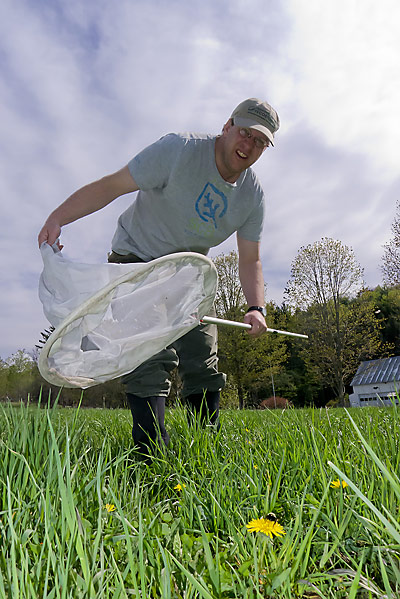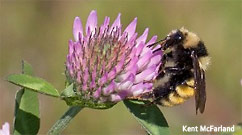The Buzz on Bumblebees
 WOODSTOCK, VT – In the delicate and passionate matters of “the birds and the bees,” Vermont may have no greater authority than Kent McFarland.
WOODSTOCK, VT – In the delicate and passionate matters of “the birds and the bees,” Vermont may have no greater authority than Kent McFarland.
Courtship and reproduction occupy a good portion of McFarland’s workday. No breeding behavior is too racy, no animal instincts off limits.
But McFarland won’t offer his expertise for use in your bedroom. He’s a wildlife biologist. And he actually studies birds and bees.
Having spent the better part of two decades researching some of the state’s rarest birds, McFarland, senior conservation biologist at the Vermont Center for Ecostudies (VCE), is now turning his sights to bumblebees.
Across the continent, certain bumblebee species are declining at an alarming pace, or even vanishing altogether. Threats range from pesticides to habitat loss to foreign diseases. So McFarland is recruiting volunteers for an ambitious project: an assessment of Vermont’s 20 or so bumblebee species. It appears no other state has embarked on such an adventure.
When he’s not in pursuit of birds, or studying rare butterflies on New Hampshire’s Mount Washington, or chasing dragonflies for another project, or serving as a firefighter in his hometown of Woodstock, McFarland is out with his insect net catching bees. On a perfect afternoon this month he is unshaven, wearing an old T-shirt, dirty pants and rubber barn boots, and toting a net he calls “Big Papi,” nickname for Boston Red Sox slugger David Ortiz.
“I’m bee-obsessed now, I really am,” McFarland says. “I break for bees, my friend.”
Until now, European honeybees – not bumblebees – have attracted much of the buzz. Honeybee colonies across the nation have been dying off, something beekeepers call Colony Collapse Disorder. Lesser known is a disturbing decline in bumblebees.
Honeybees are European imports, but bumblebees are native insects that McFarland says “work hard for us” as pollinators of clover, blueberries, cranberries, apples, raspberries, and many wild plants.
“When it’s cold, when the honeybees can’t even operate,” McFarland says, “bumblebees are out there pollinating like mad.” The Vermont Bumblebee Survey only represents McFarland’s latest obsession with some sort of flying animal. As a kid growing up in Pennsylvania and Oregon, he didn’t care much for wildlife “unless I could shoot at it or catch it on a hook.” But when a stint as a Peace Corps volunteer landed him among ornate tropical birds in Paraguay, McFarland himself became hooked.
He has spent much of his professional life on mountaintops researching Bicknell’s Thrush, a rare, little brown bird with a swirling, fluty song and an odd mating behavior. McFarland and his colleagues at VCE have become international experts on the thrush, its conservation and the status of other high-elevation songbird species.
But when mornings end with songbirds, when the thrushes stop singing in mountains, ornithologists look for afternoon diversions. “When the birds shut up, I’m not going to take a nap,” McFarland says. “I’m going to look at something else. So I started looking at butterflies.”
From 2002 through 2007, McFarland organized more than 140 volunteers to identify and count butterflies across Vermont. The result is the Vermont Butterfly Atlas, the first comprehensive assessment of the state’s 103 butterfly species, establishing a baseline of knowledge for future conservation and continued monitoring.
With the butterfly project complete, McFarland, almost on a whim, attended a bee identification workshop offered by Leif Richardson, a Montpelier ecologist who is co-authoring a reference guide to North American bumblebees. Another flying animal beckoned. But it was one of Richardson’s discoveries that got McFarland thinking seriously about bumblebees.
Richardson had noticed here in Vermont that the Rusty-patched Bumblebee, once abundant, had all but vanished sometime in the 1990s. One of Vermont’s bumblebee species was suddenly gone. Others could be in trouble as well.
Few if any biologists were monitoring the disappearance of Rusty-patched Bumblebee in the state. Instead, Richardson noticed its exit after the fact while cataloguing more than 1,000 bee specimens housed at the University of Vermont.
For years, entomology students at UVM would head out with nets to catch nearly anything with wings and six legs. Their specimens, routinely including Rusty-patched Bumblebees, would end up in the UVM insect collection. But by the late 1990s, students were no longer adding Rusty-patched Bumblebees to the collection. The students, by not finding the bumblebee, were unwittingly documenting its disappearance.
“It goes from dirt-common to gone,” says McFarland.
Few self-respecting biologists would ignore something that dramatic. VCE has a reputation for citizen-science – recruiting volunteers to contribute to research under the guidance of professional biologists. (Besides the butterfly atlas, VCE will publish an atlas of Vermont’s breeding birds based largely on the observations of 350 volunteer birdwatchers.)
McFarland, with help so far from two dozen volunteers, intends to produce by year’s end a state-of-the-bumblebee report. It will be less sweeping than the bird or butterfly atlases, owing to a shortage of funding, which now comes from two private foundations. “Bees should be sexy,” he says, “but it’s really hard to get money for them.”
Despite having funds for only a pilot project, McFarland says the report will offer landowners, orchardists, conservationists and policy makers a baseline assessment of Vermont’s bumblebees and help guide decisions about future research.
“Bumblebees have been providing pollinating services without much recognition,” says Trish Hanson, forest entomologist with the Vermont Agency of Natural Resources. “The more we know about them, the better we can protect them if possible.”
For the project, good photographs suffice for the proper identification of some bumblebee species. Other bumblebee species must be collected, dispatched and identified by experts in the lab. Project volunteers can be trained in a day or so to collect bees and process them for identification.
The project deserves praise because it is involving non-scientists in something as esoteric as insect conservation, Richardson says, and puts bumblebee threats into public discourse. The baseline bee population data will be invaluable for biologists working to understand bumblebee populations over time.
“That’s an urgent need everywhere for bees because things are changing so fast for them,” he says.
The Rusty-patched Bumblebee has declined across its range. One hypothesis is that it fell victim to an imported pathogen. Bumblebees are great pollinators of tomatoes. With more American tomatoes being grown in hothouses, European bee breeders obtained two American bumblebee species and reared colonies that were later shipped back to the US for use in the commercial pollination of tomatoes. Those returning bees, according to biologists, may have acquired a European disease to which American bees are defenseless.
McFarland dreams of finding disease-resistant Rusty-patched Bumblebees here in Vermont that could help in the restoration of the species, in the same way the American Chestnut Foundation (with an office in South Burlington) is working to restore trees resistant to chestnut blight.
But McFarland doesn’t want to stop with bumblebees. He points out that Vermont is home to about 270 different bee species, many of which warrant more attention. From there, McFarland’s only problem is that he’ll never run out of flying animals.
“Frankly, the world has been beaten up – any group that we look at, we’re going to find something wrong, something going on,” McFarland explains. “I don’t know. Maybe except cockroaches? Maybe not. There are probably strange cockroaches that deserve our attention.”


